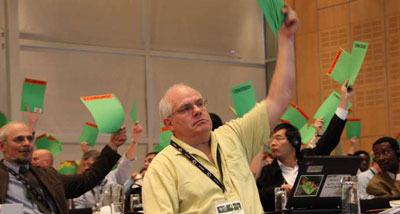Conversion criterion: Time for a change
As someone who has participated in FSC General Assembly (GA) events for almost 30 years, Richard Donovan took a moment to share his perspective on the proposed Motion 37 at this year's GA in Bali, Indonesia.
This year’s GA continues to touch on one of the most heated topics in the FSC system – conversion of forest into plantations or other land uses. Motion 37 focuses on the FSC Policy to Address Conversion and Remediation Framework.
FSC chose 1994 as a cut-off date when plantations converted from natural forests are excluded from FSC certification. This conversion criterion has so far hindered FSC from influencing the management of forests in many tropical areas where conversion has taken place, particularly since 1994.
Now FSC has changed that the forest conversion that happened between 1994 to 2022 will be eligible for certification if companies remediate the wrongs of the conversion. The scheme is now standing on the precipice of major functional evolution for the FSC system with the creation of a new policy addressing conversion – Motion 37 while being more proactive on environmental and social remedy.

“I believe it is time to move ahead as proposed per Motion 37. No motion is perfect, but this motion requires engaging directly affected stakeholders and rightsholders to address remedy issues caused by conversion. At the same time this puts FSC in a much more realistic position globally on conversion everywhere, not just Indonesia or Africa, but everywhere,” said Richard.
Motion 37 specifically requires remedy, based on deep and balanced inputs from all FSC chambers and sub chambers, as well as FSC Board of Directors. It imposes heavy costs on companies who have converted forests and allows the FSC to engage in countries where governments were fostering conversion from late 1994 to December 2020.
“We cannot, as a system, continue to wallow in this topic – we need to get beyond talking and theory to real progress on social and environmental remedy in the field. At the same time, we need to continue to listen carefully to FSC member concerns and use their observations to improve the Motion 37’s implementation going forward,” stated Richard.
Some stakeholders have criticised the whole “conversion and remedy” process, expressing the concern that this motion has moved too quickly, and at times demonstrating mistrust of FSC staff, board, or system, among others.
There are now many companies keen on getting into the FSC system and willing to put funds and efforts into correcting past wrongdoings in terms of converting forests. However, there is no pathway for them so far.
Taking rubber as a concrete example, 50% of rubber conversion globally happened after 1994. As a result, FSC cannot be a scalable solution for the tire sector, unless there is a path for remedy established in our system, as proposed in Motion 37.
Within the relatively new GPSNR (Global Platform for Sustainable Natural Rubber), whose membership represents 60% of the global rubber market, tire and automotive makers and rubber companies are evaluating their options for sustainable natural rubber sourcing, and assurance model for credible claims. But if there is no route for FSC certification for more than half of the rubber supply, then they will look for and develop alternative solutions.
“The sector will not wait until the next GA, as there is an urgency for the tire companies to adapt their sourcing to comply with the new EU Regulation on Deforestation-free products, which currently includes rubber,” explained Richard.
As the world’s most rigorous scheme for forestry, FSC certification has the potential to improve the livelihoods of the millions of smallholder farmers who produce rubber and protect the rights of different stakeholders, while not only preventing new deforestation but also helping to restore the past conversion.
“We will learn more as we implement the already Board-approved Policy to Address Conversion, the Remedy Framework and the new Policy for Association (PfA). But we need to learn through practice, not theory, and Motion 37 sets us up to do this,” explains Richard.
“The people and ecosystems that have long been waiting for remedy and restitution depend on FSC’s approach. The remedies cannot be successful unless we also offer the possibility of reward – access to FSC membership and potentially certification – both rigorous, but necessary. We need change, now.”

